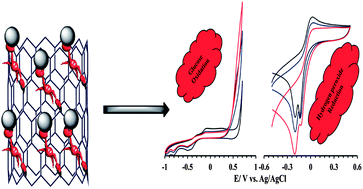The fabrication and characterization of Cu-nanoparticle immobilization on a hybrid chitosan derivative-carbon support as a novel electrochemical sensor: application for the sensitive enzymeless oxidation of glucose and reduction of hydrogen peroxide
Abstract
New hybrid chitosan derivatives (chitosan (Chit)), amine group grafted chitosan (N-Chit), and thiol group grafted chitosan (S-Chit) modified-carbon (carbon nanotubes or graphite) were prepared and used as supports for Cu-nanoparticles. The synthesized materials were characterized with different methods such as transmission electron microscopy, Brunauer–Emmett–Teller and cyclic voltammetry. The electrocatalytic effect of the nanohybrid was investigated in the reduction of hydrogen peroxide and the oxidation of glucose. It was found that the Cu nanoparticles decorate on the modified chitosan–CNT (Cu@M-Chit–CNT) exhibit a remarkable catalytic performance for H2O2 reduction and glucose oxidation. Hydrodynamic amperometry was used for the electrochemical determination of H2O2 and glucose. The linear range for H2O2 was from 0.1 to 1000 μmol L−1 with a detection limit of 0.025 μmol L−1, whereas the linear range for glucose was from 0.5 to 1000 μmol L−1 with a detection limit of 0.05 μmol L−1. In addition, Cu@N-Chit–CNT/GCE and Cu@Chit–CNT/GCE showed a good selectivity for H2O2 and glucose detection in the presence of dopamine, ascorbic acid and uric acid. The kinetic parameters such as the electron transfer coefficient and the catalytic reaction rate constant were also determined for glucose and H2O2. Finally, the modified electrode is the most sensitive probe ever reported and can be used to achieve the real-time quantitative detection of H2O2 and glucose for biological applications.

- This article is part of the themed collection: JMC B Top Picks web collection: Seeing the unseen: Advances in bioimaging and biosensors

 Please wait while we load your content...
Please wait while we load your content...